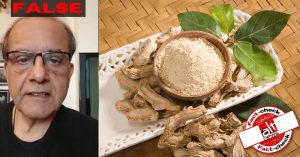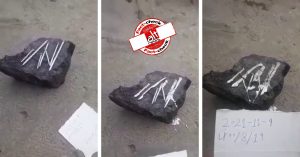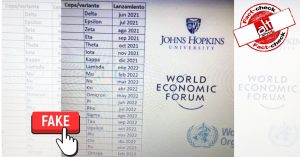On the 26th of June 2019, Shiv Shankar Gupta, the chairman of Godhum grains & farms products, conducted a press conference while alleging that two popular brands of salt in India contain known toxic chemicals according to an American lab report.
On the same day, multiple mainstream media outlets in India carried reports titled “Premium salt in India contains deadly cyanide” which was based on a publication by a news agency IANS which had covered the press conference.
‘Premium salt’ in India contains deadly cyanide. US Report pic.twitter.com/WMFp9yVWzp
— Rajnish Sharma (@rajnish1Midas) June 28, 2019
The articles quoted Shiv Shankar Gupta, and alleged that America West Analytical Laboratory, had ‘revealed’ that two brands of salt, consumed en masse in India contained alarmingly high levels of potassium ferrocyanide (PFC).
The levels reported were: 4.71 mg/Kg in Sambhar refined salt, 1.85 mg/Kg in Tata salt, and 1.9 mg/Kg in Tata salt lite. The article reported stated that Mr Gupta, suggested that nowhere else in the world was PFC permitted in the edible salt industry, and described it as ‘a deadly poison’.
In addition to mainstream news outlets, Website called Great Game India published a story about presence of toxic chemicals in two brands of salt widely used in India. Beyond the reportage by IANS, this article also points out to a pending public interest litigation (PIL) and other related information.
In the course of this article, we will examine the following claims made in the aforementioned press conference and the media report that covered it:
1) The veracity of the US lab report based on which the ‘toxic salt’ claim was made
2) Whether Potassium Ferrocyanide (PFC) is toxic for human consumption
3) Whether PFC is a legal component in food consumption of other countries
4) The differences between PFC and cyanide- a highly toxic substance linked with instant death
False claims
- We found the claim regarding the levels of PFC as reported by an American Lab as false. In an email exchange with the American West Analytical Laboratories, the labs were requested for the information regarding the laboratory tests conducted on the various salt brands, which were subsequently claimed by Gupta.
Kyle Gross, Director of American West analytical laboratories, responded with a prepared statement categorically denying that they cannot analyse or disperse information on PFC levels, as well as refrain from commenting on the client or the work conducted at the lab to the third parties, i.e. Mr Gupta . The full statement is available here.
- The second false claim was that PFC is toxic and that the allegedly reported levels of PFc in salt samples from India were alarmingly high.PFC’s use as a food additive in salt arises from its anti-caking properties allowing salt to be ‘free-flowing’. This has the obvious advantage that the quantities of salt used for human consumption can be more fine-tuned as compared with rock-salt.
The toxicity and safety of PFC and other ferrocyanide salts (such as sodium and calcium) was comprehensively reviewed in 2018 by an expert panel of the European Food Safety Authority.
This review concluded that the use of potassium (as well as sodium or calcium) ferrocyanides as food additives presented no reason for concern. It was neither genotoxic (i.e. it did not alter the genetic make-up of cells), nor carcinogenic (causing cancerous tumours).
In very large quantities, its toxicity was demonstrated in rodent kidneys and adverse effects were observed at about 4.1 mg/Kg PFC of body weight everyday over a two year period.
For human consumption, the expert panel concluded that the acceptable daily intake of PFC was 0.03 mg/Kg body weight per day expressed as the ferro-cyanide ion.
The Food Safety and Standards Authority of India also clarified that allowed levels of PFC is 10 mg per Kg of salt and that the reported limits in media were well within the allowed limits.
Ferrocyanides are used as anti-caking agents in processing of salt which is safe for consumption and they’re different…
Posted by Food Safety and Standards Authority of India on Thursday, 27 June 2019
Furthermore, to attain a level of PFC of 10 mg/Kg, the required salt consumption for a human would be 3 gm of salt per Kg body weight. This amount for an average human of 70 Kg weight would be 210 gm every day. This level is highly unlikely in humans as the maximum salt intake is largely 10-12 gm per day. In comparison, the recommended salt intake for an adult is less than 6 grams a day.
- The third claim that is verifiably false is that it is illegal in other countries to use PFC in salt manufacturing. The European Food Safety Agency allows the use of PFC as an additive in salt and its substitutes like low sodium salts. For example the salt manufactured and sold by Premier Foods under the Saxa brand in many British supermarkets lists 2 ingredients, salt and an anti-caking agent (sodium hexacyanoferrate)
- Multiple media articles referred to PFC as ‘deadly cyanide’ in the title of their reports. Cyanide is the popular term used for Potassium Cyanide which is different from Potassium Ferrocyanide (PFC), the anti-caking-agent used in salts. This is deliberately misleading and misinformed.Potassium ferrocyanide is an inorganic compound with the chemical formula K4[Fe(CN)6].3H20.
An alternative name for the ferrocyanide ion is hexacyanoferrate and may be preferable since it does not lead to a confusion with ‘cyanide’ for the lay person. The potassium, sodium and calcium salts of ferrocyanide (or hexacyanoferrate) have the same properties. Also, it does NOT decompose into cyanide which is a well-known lethal toxin.
Hence, it is false and misleading to suggest that PFC is related to potassium cyanide. While the chemical bond between iron (Fe) and cyanide radical is strong. PFC is very poorly absorbed in humans between- 0.25 – 0.42% of the amount ingested.
Tata’s rebuttal
Salt is the oldest known food seasoning and preservative. India produces some 27 million tons of it and ranks third in the world behind USA and China. Within India, Tata Salt is the leading producer of cooking and table salt and markets its brand with the slogan, ‘Desh ka namak’. Tata Salt put out a statement rebutting the claims made by media organisations and Mr Gupta. They have argued that their salt does contain PFC, that the levels of PFC are well within the limits mandated by regulatory guidelines and that their salt is safe. Tata’s statement also gives web links to regulatory standards from around the world that set out the use of PFC as an additive.
Conclusion
Science journalism in India is woefully lacking in rigour and understanding. This news report was easily refuted as it was based on concocted and demonstrably false statements.
The exaggerated of toxic chemicals in common and widely used brands of salt caused confusion in the minds of the public. Many confused ‘cyanides’ with ‘ferrocyanide’, causing a further alarm in the general populace.
The PFC levels in Tata salt as clarified by FSSAI are well within permissible limits.
Independent journalism that speaks truth to power and is free of corporate and political control is possible only when people start contributing towards the same. Please consider donating towards this endeavour to fight fake news and misinformation.




